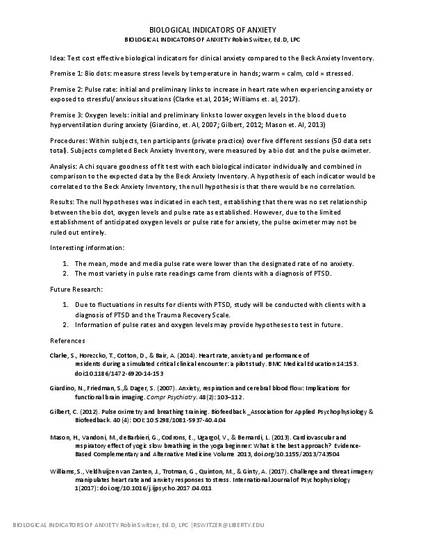
Dataset
Biological Indicators of Anxiety
(2018)
Description
Idea: Test cost effective biological indicators for clinical anxiety compared to the Beck Anxiety Inventory.
Premise 1: Bio dots: measure stress levels by temperature in hands; warm = calm, cold = stressed.
Premise 2: Pulse rate: initial and preliminary links to increase in heart rate when experiencing anxiety or exposed to stressful/anxious situations (Clarke et.al, 2014; Williams et. al, 2017).
Premise 3: Oxygen levels: initial and preliminary links to lower oxygen levels in the blood due to hyperventilation during anxiety (Giardino, et. Al, 2007; Gilbert, 2012; Mason et. Al, 2013)
Procedures: Within subjects, ten participants (private practice) over five different sessions (50 data sets total). Subjects completed Beck Anxiety Inventory, were measured by a bio dot and the pulse oximeter.
Analysis: A chi square goodness of fit test with each biological indicator individually and combined in comparison to the expected data by the Beck Anxiety Inventory. A hypothesis of each indicator would be correlated to the Beck Anxiety Inventory, the null hypothesis is that there would be no correlation.
Results: The null hypotheses was indicated in each test, establishing that there was no set relationship between the bio dot, oxygen levels and pulse rate as established. However, due to the limited establishment of anticipated oxygen levels or pulse rate for anxiety, the pulse oximeter may not be ruled out entirely.
Keywords
- research,
- chi square goodness of fit,
- anxiety,
- pulse rates,
- blood oxygen levels,
- bio dots
Disciplines
Publication Date
Winter December, 2018
Citation Information
Robin Switzer. "Biological Indicators of Anxiety" (2018) Available at: http://works.bepress.com/robin-switzer/4/
